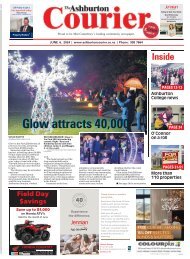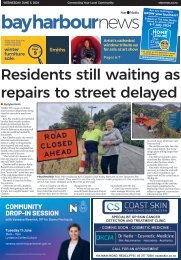The Star: June 29, 2017
Create successful ePaper yourself
Turn your PDF publications into a flip-book with our unique Google optimized e-Paper software.
<strong>The</strong> <strong>Star</strong> Latest Christchurch news at www. .kiwi<br />
Thursday <strong>June</strong> <strong>29</strong> <strong>2017</strong> 45<br />
<strong>Star</strong> Classifieds<br />
• Phone our local team 03 379 1100 • Email star.class@starmedia.kiwi<br />
Trees and Power Lines<br />
<strong>The</strong> responsibilities of tree owners and Orion under the<br />
Electricity (Hazards from Trees) Regulations 2003<br />
Orion New Zealand owns and operates the electricity distribution network in central<br />
Canterbury between the Waimakariri and Rakaia rivers and from the Canterbury coast<br />
to Arthur’s Pass. Trees touching power lines account for 10-20% of all unplanned power<br />
outages on our network. If you see a tree touching a power line, or any other hazardous<br />
tree condition, please contact us immediately on 03 363 9898 or 0800 363 9898.<br />
This advertisement provides a general notice of the Electricity (Hazards from Trees)<br />
Regulations 2003 and the dangers of trees near power lines. More detail on these issues<br />
can be found on our website www.oriongroup.co.nz or by phoning us on 03 363 9898.<br />
<strong>The</strong> Electricity (Hazards from Trees) Regulations 2003<br />
<strong>The</strong> regulations set out the responsibilities of electricity line companies and tree owners.<br />
<strong>The</strong> purpose of the regulations is to protect the safety of the public and help to ensure a<br />
secure supply of electricity. <strong>The</strong> regulations:<br />
• define safe separation distances between trees and power lines<br />
• specifies who is responsible for ensuring clearances are maintained<br />
• places potential liability on the tree owner if any damage or accident occurs due to<br />
trees touching power lines. (Note that the word “trees” includes all types of vegetation,<br />
including shrubs, hedges and climbing vines.)<br />
What are the dangers?<br />
Trees near power lines need to be trimmed or removed for the following reasons:<br />
• children like to climb trees and when trees are close to power lines there is a risk of<br />
serious injury or death<br />
• in severe weather conditions, vegetation can become electrically “live” and may<br />
electrocute anyone or anything that touches it<br />
• while a tree may not touch a power line in fine weather, branches can bend or break in<br />
wind or snow storms, causing serious damage and possibly prolonged power outages<br />
• in dry conditions, electrical sparking caused by branches or windblown debris on lines<br />
may cause fires.<br />
Minimum distances required between trees and power lines<br />
<strong>The</strong> minimum distances that must be maintained between trees and power lines, defined in<br />
the regulations, are outlined in the diagram to the right. A common sense approach, by tree<br />
owners trimming trees early, will generally prevent trees touching power lines.<br />
To maintain a safe distance from power lines some trees require cutting or trimming<br />
more frequently than other trees, but if it is determined that cutting or trimming cannot<br />
satisfactorily meet the requirement then removing the tree is recommended. Other<br />
situations may require trees to be felled because they are at a distance that is considered<br />
to be a hazard due to falling during storms or being diseased.<br />
Orion’s tree management programme<br />
Orion’s tree management programme is largely governed by the Electricity (Hazards from<br />
Trees) Regulations 2003. Our programme involves education, monitoring and the cut/trim<br />
or removal of trees that threaten to come into contact with power lines. Through this<br />
programme we work with tree owners to minimise the risk of their trees touching power lines.<br />
We currently undertake periodic cutting or trimming of vegetation within the notice zone.<br />
<strong>The</strong> intent of this cutting or trimming is to support safety and reduce the risk of power<br />
outages. This periodic cutting or trimming by us does not remove the tree owner’s<br />
responsibilities and in the case of fast growing species may not be sufficient to ensure<br />
that trees remain outside of the growth limit zone. You will be notified prior to any periodic<br />
trimming being carried out and the work will be completed by arborists carrying Orion<br />
identification.<br />
If Orion becomes aware of a tree which is within the ‘Notice zone’ (see Tree “A” in the diagram<br />
below) then we are required to issue the tree owner with a Hazard Warning notice. For trees<br />
within the ‘Growth limit zone’ (see Tree “B” in the diagram below) we are required to issue the<br />
tree owner with a Cut or Trim notice.<br />
What is a hazard warning notice?<br />
If a tree is within the “Notice zone” (see Tree “A” in the diagram), we are required to issue a<br />
hazard warning notice to the tree owner.<br />
Tree “A”<br />
Notice<br />
zone<br />
Growth<br />
limit<br />
zone<br />
Tree “B”<br />
Power line Notice zone Growth limit zone<br />
66kV (high voltage) 5.0 metres 4.0 metres<br />
33kV (high voltage) 3.5 metres 2.5 metres<br />
11kV (high voltage) 2.6 metres 1.6 metres<br />
400V/230V (low voltage) 1.5 metres 0.5 metres<br />
Note:<br />
1) <strong>The</strong>se distances are from the power line, not the power pole<br />
V = Volts; kV = kilo Volts ie 1,000 Volts<br />
2) <strong>The</strong>se distances are a minimum and apply in all conditions including high wind or snow<br />
3) In most instances the power lines that go to a house or building are low voltage power<br />
lines. Power lines that go down a street may be low or high voltage.<br />
Trimming trees near power lines<br />
Trimming trees near power lines can be extremely hazardous and the dangers should not<br />
be underestimated. Contact with a power line can cause:<br />
• injury or death to yourself, family or passers by<br />
• injury or death to livestock<br />
• damage to property and other trees<br />
• damage to electrical appliances<br />
• damage to power supply facilities<br />
• damage to third parties.<br />
We recognise that the public is not always experienced in tree trimming, so we are happy<br />
to advise you on this. We can arrange for trees near power lines to be trimmed at your<br />
cost. If, however, you prefer to arrange your own tree trimming, we recommend you hire<br />
professionals with the necessary expertise and safety procedures to competently carry out<br />
this work.<br />
If you or someone working for you intends to work within 4 metres of power lines, a close<br />
approach consent is required from Orion before you start. As a tree owner you may be liable<br />
for any damage caused by carrying out trimming or felling of trees.<br />
A hazard warning notice alerts the tree owner that the tree has encroached the notice zone<br />
and that if it encroaches the “Growth limit zone” (see Tree “B” in the diagram) a cut or trim<br />
notice may be immediately given to the tree owner (see above).<br />
<strong>The</strong> growth limit zone is the area around a power line which trees must not encroach even<br />
in windy or snow conditions. <strong>The</strong> notice zone is a distance one metre beyond the growth<br />
limit zone.<br />
What is a cut or trim notice?<br />
If we become aware that a tree has encroached on the “Growth limit zone”, we will give<br />
notice in writing to the tree owner that the tree must be cut or timed to maintain the<br />
distances prescribed in the regulations, and the timeframes for action.<br />
If no action is taken Orion may then trim the tree and seek to recover costs.<br />
Who pays for the cut or trim?<br />
Orion is responsible for the first cut of trees near power lines, where the first cut is on a<br />
property basis, not owner basis. We have already met this obligation by completing a first cut<br />
of vegetation on all our lines.<br />
<strong>The</strong> tree owner will need to organise and pay for any subsequent and future cuts or trims.<br />
We are happy to provide tree owners with a list of approved arborists who can carry out this<br />
work, and also advise the best solution given the circumstances.<br />
What fines can be imposed?<br />
A tree owner commits an offence where a cut or trim notice is given, and without reasonable<br />
excuse, the tree owner fails to have the tree cut or trimmed and/or fails to advise us of the<br />
time and location of the cut or trim.<br />
A person who commits such an offence is liable on summary conviction to a fine not<br />
exceeding $10,000. If the offence continues, that person is also liable for a further fine of<br />
not more than $500 for every day or part day during which the offence continues.<br />
Contact us if in any doubt about your tree<br />
We aim to work with tree owners to ensure safety is maintained and power outages are<br />
minimised. We will actively work with tree owners to see trees are trimmed or cut before<br />
regulatory powers are applied. However, as we wish to ensure the safety and security of the<br />
public, we will use the regulations where necessary.<br />
Please contact us or an approved Orion tree trimming contractor to help with your trees,<br />
or to discuss your options.<br />
ORION NEW ZEALAND LIMITED<br />
565 Wairakei Road, Christchurch 8053<br />
PO Box 13896, Christchurch 8141<br />
Phone +64 3 363 9898<br />
info@oriongroup.co.nz<br />
oriongroup.co.nz<br />
Orion New Zealand Limited owns and operates the electricity distribution network<br />
in central Canterbury between the Waimakariri and Rakaia rivers.


















